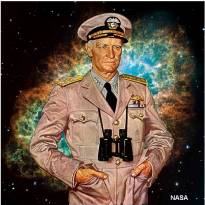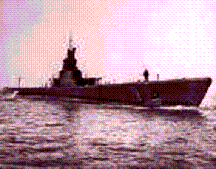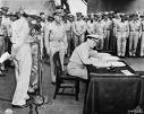ADMARIL CHESTER NIMITZ
AND THE
MIRACLE AT MIDWAY
 Why did we grow up speaking English instead of Japanese? Why did we learn to pledge allegiance to a flag with white and red stripes instead of a white flag with a big red dot? The land we live in today would be very different from what we know had God not worked a miracle, and for that miracle God used a man who today is almost forgotten. When all seemed lost, this leader made tough, painful decisions, and under the unbearable pressure of mortal combat took the necessry risks which resulted in the triumph of freedom that preserved the nation of liberty that we enjoy today..
Why did we grow up speaking English instead of Japanese? Why did we learn to pledge allegiance to a flag with white and red stripes instead of a white flag with a big red dot? The land we live in today would be very different from what we know had God not worked a miracle, and for that miracle God used a man who today is almost forgotten. When all seemed lost, this leader made tough, painful decisions, and under the unbearable pressure of mortal combat took the necessry risks which resulted in the triumph of freedom that preserved the nation of liberty that we enjoy today..
grandfather, Charles Nimitz, a German immigrant, who had been a merchant seaman and had raised Chester in a hotel which he had built and molded to look like a steam ship. Later, Chester’s mother married her late husband’s younger brother.
 Despite the influence from his dearly beloved grandfather, young Chester’s first ambition was a military career in the army. He was rejected from West Point because no positions were available. However, when Chester heard of a competitive opening available at the Naval Academy in Annapolis, Maryland, Chester did not even wait to graduate from high school. Having won the appointment he enrolled in the academy in 1901 where four years later in 1905 he graduated 7th in his class of 114.
Despite the influence from his dearly beloved grandfather, young Chester’s first ambition was a military career in the army. He was rejected from West Point because no positions were available. However, when Chester heard of a competitive opening available at the Naval Academy in Annapolis, Maryland, Chester did not even wait to graduate from high school. Having won the appointment he enrolled in the academy in 1901 where four years later in 1905 he graduated 7th in his class of 114.
 Naval regulations at that time required an officer to serve two years at sea before receiving a commission. His first assignment was to the Middle East aboard the USS battleship Ohio, and then later the USS cruiser Baltimore. Having received his commission as an ensign in 1907 he served short term on several destroyers, the last of which was the USS Decatur where disaster struck in the Philippines. Nimitz ran the ship aground on a mud bank and had to rescue a man from drowning who had fallen overboard in the accident. However, at his court-martial, instead of a dismissal, Nimitz received a letter of reprimand.
Naval regulations at that time required an officer to serve two years at sea before receiving a commission. His first assignment was to the Middle East aboard the USS battleship Ohio, and then later the USS cruiser Baltimore. Having received his commission as an ensign in 1907 he served short term on several destroyers, the last of which was the USS Decatur where disaster struck in the Philippines. Nimitz ran the ship aground on a mud bank and had to rescue a man from drowning who had fallen overboard in the accident. However, at his court-martial, instead of a dismissal, Nimitz received a letter of reprimand.
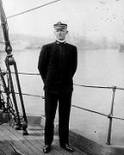
 Chester’s focus changed in 1909 when he was assigned to submarine service and eventually was promoted to Lieutenant in 1910, and then was named commander of the 3rd Submarine Division Atlantic Torpedo Fleet in October of 1911. In 1912, while on assignment to oversee the fitting out of the USS Skipjack, Nimitz was decorated with the silver Lifesaving Medal for rescuing a drowning sailor. One of his greatest contributions to the submarine was his recommendation to change the fleet from gasoline to the safer diesel power. In 1913 he was sent to study diesel power in Germany and became one of the US Navy’s foremost experts in the field. Disaster struck again in an accident while demonstrating a diesel engine when his finger was caught in a gear, crushing the end of his finger. His naval career was spared by his Annapolis class ring, which jammed in the gear and kept him from loosing his whole hand.
Chester’s focus changed in 1909 when he was assigned to submarine service and eventually was promoted to Lieutenant in 1910, and then was named commander of the 3rd Submarine Division Atlantic Torpedo Fleet in October of 1911. In 1912, while on assignment to oversee the fitting out of the USS Skipjack, Nimitz was decorated with the silver Lifesaving Medal for rescuing a drowning sailor. One of his greatest contributions to the submarine was his recommendation to change the fleet from gasoline to the safer diesel power. In 1913 he was sent to study diesel power in Germany and became one of the US Navy’s foremost experts in the field. Disaster struck again in an accident while demonstrating a diesel engine when his finger was caught in a gear, crushing the end of his finger. His naval career was spared by his Annapolis class ring, which jammed in the gear and kept him from loosing his whole hand.
 Chester Nimitz was married on April 9, 1913 to Catherine Freeman, daughter of an affluent New England worker. Eventually he became the devoted father of four children: Catherine Vance, Chester Jr., Anna, & Mary. His only son, Chester Nimitz Jr., followed his father’s steps into a naval career and eventually retired with the rank of Rear Admiral.
Chester Nimitz was married on April 9, 1913 to Catherine Freeman, daughter of an affluent New England worker. Eventually he became the devoted father of four children: Catherine Vance, Chester Jr., Anna, & Mary. His only son, Chester Nimitz Jr., followed his father’s steps into a naval career and eventually retired with the rank of Rear Admiral.
 The years following were mostly quiet. His command did not see combat in World War I. He continued to receive promotions, first to lieutenant commander, then aid to Rear Admiral Samuel S Robinson, and then his chief of staff. Nimitz served as officer aboard several war ships including the USS Battleship South Caroline and the USS Chicago. He studied in the Naval War College in 1922 and after graduating was eventually promoted to Captain and took command of Submarine Division 20 and later was given command of the USS cruise ship Augusta in 1933. In 1938 he was promoted to rear admiral and appointed commander of Battleship Division 1. Now, with vast experience in submarines an surface ships, Admiral Nimitz
The years following were mostly quiet. His command did not see combat in World War I. He continued to receive promotions, first to lieutenant commander, then aid to Rear Admiral Samuel S Robinson, and then his chief of staff. Nimitz served as officer aboard several war ships including the USS Battleship South Caroline and the USS Chicago. He studied in the Naval War College in 1922 and after graduating was eventually promoted to Captain and took command of Submarine Division 20 and later was given command of the USS cruise ship Augusta in 1933. In 1938 he was promoted to rear admiral and appointed commander of Battleship Division 1. Now, with vast experience in submarines an surface ships, Admiral Nimitz
advocated that, with the evolution of Naval warfare, the battleship was to loose its prominence. The future pointed to aircraft carriers taking a leading roll.
 Meanwhile, big trouble was brewing in the Far East. Since Japan had virtually no natural resources of her own she expanded her territory by annexing Korea and then Manchuria. President Roosevelt denounced the Japanese expansion and in mid 1940 banned exportation of arms, scrap iron, and strategic materials. When this did not produce the desired results, President Roosevelt led a worldwide embargo of oil and froze Japanese overseas assets. This infuriated the Japanese Empire as they convinced their people that now the United States was the aggressor. Japan saw two alternatives. Either she could accept the humiliation of capitulating to the demands of the United States and other foreign governments, or she could crush the opposition and expand her empire to include the resources she sought.
Meanwhile, big trouble was brewing in the Far East. Since Japan had virtually no natural resources of her own she expanded her territory by annexing Korea and then Manchuria. President Roosevelt denounced the Japanese expansion and in mid 1940 banned exportation of arms, scrap iron, and strategic materials. When this did not produce the desired results, President Roosevelt led a worldwide embargo of oil and froze Japanese overseas assets. This infuriated the Japanese Empire as they convinced their people that now the United States was the aggressor. Japan saw two alternatives. Either she could accept the humiliation of capitulating to the demands of the United States and other foreign governments, or she could crush the opposition and expand her empire to include the resources she sought.
Japan had been preparing for war. The United States was not. Sentiment in the United States strongly opposed war in Europe or in the Pacific. The US government expected that the Japanese Empire would capitulate to international pressure and that problems could be resolved peacefully. They were wrong. Japan considered such a capitulation to be an intolerable humiliation. So the Empire prepared for a fight. She had already amassed an immense armada, which included 9 battleships and 11 aircraft carriers – more carriers than in all the rest of the world’s navies combined.
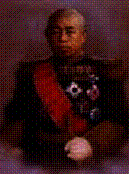
 Admiral Yamamoto, the commander of the Japanese navy, had opposed war with the United States. Having studied at Harvard, he knew that the vast resources and the industrial might of America could be converted into a titanic military machine. But once Yamamoto knew that his government was committed to war, the admiral staked his success on striking a decisive blow early in the conflict, annihilating American naval power before the nation had a chance to prepare. On Sunday, December 7, 1941 a vast Japanese armada, which included six aircraft carriers, crossed four thousand miles of ocean undetected and launched 353 warplanes against US naval instillations at Pearl Harbor.
Admiral Yamamoto, the commander of the Japanese navy, had opposed war with the United States. Having studied at Harvard, he knew that the vast resources and the industrial might of America could be converted into a titanic military machine. But once Yamamoto knew that his government was committed to war, the admiral staked his success on striking a decisive blow early in the conflict, annihilating American naval power before the nation had a chance to prepare. On Sunday, December 7, 1941 a vast Japanese armada, which included six aircraft carriers, crossed four thousand miles of ocean undetected and launched 353 warplanes against US naval instillations at Pearl Harbor.
 The United States paid a heavy price for being naive and unprepared. The Japanese ambush had destroyed or damaged 4 cruisers, 5 destroyers, 4 auxiliary ships, and had disabled all 8 battleships present, sinking 4 and crippling the other 4. About 200 American aircraft were destroyed, most of them on the ground, and nearly 2,400 servicemen and civilians were killed. And Pearl Harbor was not the only casualty. Nearly simultaneous attacks pounded Wake Island, Guam, and the Philippines. Within three weeks Wake Island and Hong Kong fell to Japan. Japanese troops advanced from Indochina into Burma and Thailand. Malaysia and Borneo were invaded. Sumatra was occupied. Port Darwin in Australia was bombed on February 19, and finally, Java was occupied in early March. In just over three months Japan had conquered one quarter of the Pacific Ocean.
The United States paid a heavy price for being naive and unprepared. The Japanese ambush had destroyed or damaged 4 cruisers, 5 destroyers, 4 auxiliary ships, and had disabled all 8 battleships present, sinking 4 and crippling the other 4. About 200 American aircraft were destroyed, most of them on the ground, and nearly 2,400 servicemen and civilians were killed. And Pearl Harbor was not the only casualty. Nearly simultaneous attacks pounded Wake Island, Guam, and the Philippines. Within three weeks Wake Island and Hong Kong fell to Japan. Japanese troops advanced from Indochina into Burma and Thailand. Malaysia and Borneo were invaded. Sumatra was occupied. Port Darwin in Australia was bombed on February 19, and finally, Java was occupied in early March. In just over three months Japan had conquered one quarter of the Pacific Ocean.
 But by providence the Japanese empire had failed to destroy their primary targets, which were the American aircraft carriers. The USS Lexington was away delivering scout bombers to Midway. The USS Saratoga had left for the west coast for upkeep. The USS Enterprise, which had been delivering planes to Wake Island, was due at Pearl Harbor on December 7th, but bad weather had delayed Enterprise and her taskforce at sea.
But by providence the Japanese empire had failed to destroy their primary targets, which were the American aircraft carriers. The USS Lexington was away delivering scout bombers to Midway. The USS Saratoga had left for the west coast for upkeep. The USS Enterprise, which had been delivering planes to Wake Island, was due at Pearl Harbor on December 7th, but bad weather had delayed Enterprise and her taskforce at sea.
 What Japan had succeeded in doing was to ignite an outrage among the American people. Pacifism virtually vanished in an instant. Former opponents of war streamed by the thousands into recruiting stations. As Admiral Bill Halsey aboard the aircraft carrier Enterprise surveyed the devastation upon his return to Pearl Harbor, he echoed the fury of the nation when his men heard him say, “When we’re done the Japanese language will be spoken only in hell.” President Roosevelt called the Secretary of the Navy Frank Knox and told him, “Tell Nimitz to get the hell to Pearl and not come back till the war is won!”
What Japan had succeeded in doing was to ignite an outrage among the American people. Pacifism virtually vanished in an instant. Former opponents of war streamed by the thousands into recruiting stations. As Admiral Bill Halsey aboard the aircraft carrier Enterprise surveyed the devastation upon his return to Pearl Harbor, he echoed the fury of the nation when his men heard him say, “When we’re done the Japanese language will be spoken only in hell.” President Roosevelt called the Secretary of the Navy Frank Knox and told him, “Tell Nimitz to get the hell to Pearl and not come back till the war is won!”
 Nimitz had his work cut out for him when he assumed command on December 31, 1941. Besides the decimated instillations and the massive causalities, moral was devastated. That’s where work began. His policy was to trust subordinates to fulfill their responsibilities without interference. Since he believed that the disaster was not the result of incompetence, he refused to dismiss any of the officers, inspiring loyalty and appreciation throughout his command.
Nimitz had his work cut out for him when he assumed command on December 31, 1941. Besides the decimated instillations and the massive causalities, moral was devastated. That’s where work began. His policy was to trust subordinates to fulfill their responsibilities without interference. Since he believed that the disaster was not the result of incompetence, he refused to dismiss any of the officers, inspiring loyalty and appreciation throughout his command.
 But he had to do more. He had to show his people that they could win and show the Japanese that they could lose. Admiral Nimitz authorized a highly secret raid on the Japanese imperial homeland devised by Admiral Ernest J. King and Air Force leader Henry H. Arnold and led by Colonel James H. Doolitle. 16 B-25 medium bombers were loaded on the aircraft carrier USS Hornet, which later met with the aircraft carrier USS Enterprise under the command of Admiral William Halsey who would provide air cover support. The plan was to launch the bombers from within 400 miles of the Japanese home islands. However, the task force met Japanese picket boats far out to sea. A warning was radioed to Japan before the boats could be destroyed. The planes now had to be launched immediately from 600 miles out. Despite the change in plans the raid was considered an overwhelming success. The bombers
But he had to do more. He had to show his people that they could win and show the Japanese that they could lose. Admiral Nimitz authorized a highly secret raid on the Japanese imperial homeland devised by Admiral Ernest J. King and Air Force leader Henry H. Arnold and led by Colonel James H. Doolitle. 16 B-25 medium bombers were loaded on the aircraft carrier USS Hornet, which later met with the aircraft carrier USS Enterprise under the command of Admiral William Halsey who would provide air cover support. The plan was to launch the bombers from within 400 miles of the Japanese home islands. However, the task force met Japanese picket boats far out to sea. A warning was radioed to Japan before the boats could be destroyed. The planes now had to be launched immediately from 600 miles out. Despite the change in plans the raid was considered an overwhelming success. The bombers
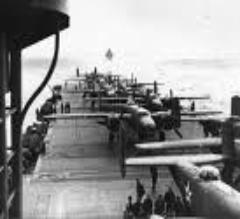
attacked the cities of Tokyo and Nagoya, causing only minor damage to military facilities, but inflicting major devastation to the morale of the Japanese people and military who thought their home islands were impregnable.
 The panic which gripped Japan after the Doolitle raid moved Japanese Admiral Yamamoto to devise a battle plan which, he hoped, would enlarge the protective perimeter around the Japanese home islands and destroy once and for all American naval power, especially its aircraft carriers. The strategy was complex. First, a decoy force would be sent to attack and invade an American outpost in the Aleutian Islands. 16 Japanese submarines were sent to watch for American carriers which were expected to charge from Pearl Harbor to defend the Aleutians. Then an air raid would attack Midway Islands, followed by an invasion force of 5000 Japanese soldiers, which was to draw the American carriers south again where an overwhelming Japanese armada was to ambush them.
The panic which gripped Japan after the Doolitle raid moved Japanese Admiral Yamamoto to devise a battle plan which, he hoped, would enlarge the protective perimeter around the Japanese home islands and destroy once and for all American naval power, especially its aircraft carriers. The strategy was complex. First, a decoy force would be sent to attack and invade an American outpost in the Aleutian Islands. 16 Japanese submarines were sent to watch for American carriers which were expected to charge from Pearl Harbor to defend the Aleutians. Then an air raid would attack Midway Islands, followed by an invasion force of 5000 Japanese soldiers, which was to draw the American carriers south again where an overwhelming Japanese armada was to ambush them.
 The US combat intelligence office had cracked the Japanese code and knew that Japan intended to attack a destination codenamed AF. Washington believed AF was Alaska. Admiral Nimitz disagreed. A deceptive message was sent reporting that Midway was short on drinking water. Shortly thereafter intelligence intercepted a Japanese transmission, “AF reports water shortage.” There was no doubt that Midway was the target, so that the decoy invasion in the Aleutians was ignored.
The US combat intelligence office had cracked the Japanese code and knew that Japan intended to attack a destination codenamed AF. Washington believed AF was Alaska. Admiral Nimitz disagreed. A deceptive message was sent reporting that Midway was short on drinking water. Shortly thereafter intelligence intercepted a Japanese transmission, “AF reports water shortage.” There was no doubt that Midway was the target, so that the decoy invasion in the Aleutians was ignored.
Guinea. A few days earlier, in an engagement with the Americans in the Coral Sea, one Japanese carrier had been sunk, one was heavily damaged, and another had lost nearly all its aircrew. Yamamoto was left with only four carriers for the ambush, but since he believed the United States had only two remaining carriers in it’s Pacific fleet, Yamamoto thought he had plenty. The USS Lexington had been sunk. The carrier USS Yorktown had been reported destroyed in the battle of the Coral Sea, but actually it had been recovered. The captain of the Yorktown said he required at least three months to repair the carrier. Under orders from Admiral Nimitz the repair was accomplished in three days. The sixteen Japanese submarines sent to keep surveillance did not arrive at their posts until after the three American carriers, the Hornet, the Enterprise, and the Yorktown, had left port. Yamamoto had no idea that it was he who was sailing into ambush.
 The total Japanese engagement fleet at Midway consisted of 4 carriers, 7 battleships, 150 support ships, 15 submarines, and 248 carrier Aircraft. The US fleet had 3 carriers, 50 support ships, 8 submarines, 233 carrier aircraft, and 127 land based aircraft from Midway. Though the American fleet had more planes, the Japanese planes were far superior in speed and agility. Otherwise the US navy was outnumbered nearly two to one. The only chance for the American navy was to find the Japanese fleet before the Japanese discovered them.
The total Japanese engagement fleet at Midway consisted of 4 carriers, 7 battleships, 150 support ships, 15 submarines, and 248 carrier Aircraft. The US fleet had 3 carriers, 50 support ships, 8 submarines, 233 carrier aircraft, and 127 land based aircraft from Midway. Though the American fleet had more planes, the Japanese planes were far superior in speed and agility. Otherwise the US navy was outnumbered nearly two to one. The only chance for the American navy was to find the Japanese fleet before the Japanese discovered them.
At first it seemed like everything was going great for Japan. Early on June 3, scout planes from Midway located the invasion fleet. High-level B-17 bombers from Midway attacked but scored no hits. Early the next morning Midway launched all B-17s to avoid being destroyed on the ground. At 4:30 AM Admiral Nagumo, commander of the Japanese carriers, launched his first wave of 108 planes against Midway. As the Japanese strike force approached, all remaining planes on Midway were scrambled. Japan lost no planes in the dogfights and lost only 6 planes to ground defenses. Japanese planes destroyed buildings and oil tanks and shot down 15 American planes, though they failed to destroy the airfield.
 Meanwhile, at 5:30 AM, while the first Japanese raid was in progress, an American scout plane spotted the first Japanese aircraft carrier and reported its position. As Admiral Nagumo prepared to launch his second wave of planes, Midway B-17s and torpedo bombers attacked him. No hits were scored, and only three torpedo bombers survived the raid. Then torpedo bombers arrived from the USS Enterprise. No hits were scored, all planes were destroyed, and only one pilot survived. Then torpedo bombers arrived from the USS Hornet. No hits were scored, and only four planes survived. Torpedo bombers attacked. Again, no hits scored. Dive-bombers and B-17s attack again from Midway. Only one Japanese support ship was hit. By this time the American fleet and Midway had attacked .
Meanwhile, at 5:30 AM, while the first Japanese raid was in progress, an American scout plane spotted the first Japanese aircraft carrier and reported its position. As Admiral Nagumo prepared to launch his second wave of planes, Midway B-17s and torpedo bombers attacked him. No hits were scored, and only three torpedo bombers survived the raid. Then torpedo bombers arrived from the USS Enterprise. No hits were scored, all planes were destroyed, and only one pilot survived. Then torpedo bombers arrived from the USS Hornet. No hits were scored, and only four planes survived. Torpedo bombers attacked. Again, no hits scored. Dive-bombers and B-17s attack again from Midway. Only one Japanese support ship was hit. By this time the American fleet and Midway had attacked .
 Suddenly the situation started to change. A Japanese scout plane reported an American aircraft carrier. It was a bad moment for the Japanese fleet. Though the American planes had scored no hits so far, they had kept the defending Japanese planes busy. Returning planes had to be recovered. Crews scrambled to change from land bombs for munitions suitable to attack the American carriers.
Suddenly the situation started to change. A Japanese scout plane reported an American aircraft carrier. It was a bad moment for the Japanese fleet. Though the American planes had scored no hits so far, they had kept the defending Japanese planes busy. Returning planes had to be recovered. Crews scrambled to change from land bombs for munitions suitable to attack the American carriers.
 Then the miracle began. Carrier dive-bombers had been searching frantically for the Japanese fleet which had changed its course to engage the American carriers. At the last possible moment, with fuel desperately low, the planes spotted a Japanese destroyer that was returning from an encounter with an American submarine. The speeding destroyer pointed the American dive-bombers directly toward their target. The defending Japanese planes, which had been distracted by the previous attacks, had been separated from their carriers and left them undefended. Then, just before Japanese planes could launch, the American dive-bombers approached for the attack. In that five-minute battle, with neither time nor fuel to spare, three unprotected Japanese carriers fell prey to the American dive-bombers: first the Carrier Kaga, and then the Akagi, and then the Soryu were reduced to floating scrap yards. Only the Hiriu remained.
Then the miracle began. Carrier dive-bombers had been searching frantically for the Japanese fleet which had changed its course to engage the American carriers. At the last possible moment, with fuel desperately low, the planes spotted a Japanese destroyer that was returning from an encounter with an American submarine. The speeding destroyer pointed the American dive-bombers directly toward their target. The defending Japanese planes, which had been distracted by the previous attacks, had been separated from their carriers and left them undefended. Then, just before Japanese planes could launch, the American dive-bombers approached for the attack. In that five-minute battle, with neither time nor fuel to spare, three unprotected Japanese carriers fell prey to the American dive-bombers: first the Carrier Kaga, and then the Akagi, and then the Soryu were reduced to floating scrap yards. Only the Hiriu remained.
The battle had been decided, but was not yet over. The carrier Hiriu launched an attack and found and bombed the carrier Yorktown. Damage control extinguished the flames and repaired damage quickly so that the Yorktown could recover her planes within an hour and forty minutes. But it still was not over. Since the flames on Yorktown had been extinguished, a second wave of planes from the last Japanese carrier Hiriu, mistaking it for another carrier, bombed the Yorktown again, this time damaging it beyond repair. The Hiriu, believing that it had destroyed two American carriers, thought that the odds were now even, one carrier against one. The Japanese aircrew was faint and exhausted. They were allowed to relax and eat before sending the third attack wave. That was the final, fatal error. While pilots were relaxing and planes were being refueled, dive-bombers from the Hornet and the Enterprise found and destroy their final target. The Hiriu was destroyed and the battle ended at 5:05 PM.
 The battle was costly for the United States, but fatal for the empire of Japan. The American losses include the carrier Yorktown, one destroyer, and 307 sailors, airmen and marines. The losses to the Japanese Empire included four carriers, two cruisers, all of its 248 carrier aircraft, and about 3,500 sailors and airmen dead. The United States could recover its losses. The Empire of Japan could not. Her resources were dwindling, and the expert airmen she lost at Midway had to be replaced with new and inexperienced pilots. And more important, Japan could never again choose the battle or take the offensive. Thereafter the United States chose what and when to attack, and the failing empire could only act defensively in a futile struggle to defend it’s territory. The course of the Pacific war and of all history thereafter was reversed during a five-minute miracle.
The battle was costly for the United States, but fatal for the empire of Japan. The American losses include the carrier Yorktown, one destroyer, and 307 sailors, airmen and marines. The losses to the Japanese Empire included four carriers, two cruisers, all of its 248 carrier aircraft, and about 3,500 sailors and airmen dead. The United States could recover its losses. The Empire of Japan could not. Her resources were dwindling, and the expert airmen she lost at Midway had to be replaced with new and inexperienced pilots. And more important, Japan could never again choose the battle or take the offensive. Thereafter the United States chose what and when to attack, and the failing empire could only act defensively in a futile struggle to defend it’s territory. The course of the Pacific war and of all history thereafter was reversed during a five-minute miracle.
 Admiral Yamamoto, commander of the Japanese Imperial Fleet, did not have long to live after the battle of Midway. In less than ten months, on April 18, 1942, naval intelligence intercepted a message that Yamamoto would be inspecting a Japanese base in the Solomon Islands. His unescorted plane was intercepted and shot out of the sky.
Admiral Yamamoto, commander of the Japanese Imperial Fleet, did not have long to live after the battle of Midway. In less than ten months, on April 18, 1942, naval intelligence intercepted a message that Yamamoto would be inspecting a Japanese base in the Solomon Islands. His unescorted plane was intercepted and shot out of the sky.
 Admiral Nimitz still had a long road ahead, but continued to prevail and never lost a fight after Midway. His victory culminated aboard the USS Missouri when, together with General Macarthur, he signed the instrument of the surrender of Japan. Having accomplished the mandate of President Roosevelt to stay in Pearl Harbor till the war was won, he returned to a hero’s welcome and was at last reunited with his family. Upon his return, a grateful nation rewarded Admiral Nimitz by appointing him Chief of Naval Operations. Thereafter he enjoyed an active retirement until his death on February 20, 1966.
Admiral Nimitz still had a long road ahead, but continued to prevail and never lost a fight after Midway. His victory culminated aboard the USS Missouri when, together with General Macarthur, he signed the instrument of the surrender of Japan. Having accomplished the mandate of President Roosevelt to stay in Pearl Harbor till the war was won, he returned to a hero’s welcome and was at last reunited with his family. Upon his return, a grateful nation rewarded Admiral Nimitz by appointing him Chief of Naval Operations. Thereafter he enjoyed an active retirement until his death on February 20, 1966.
 Fleet Admiral Chester B. Nimitz was born in Fredericksburg, Texas on February 24, 1885. He never met his father, Chester B. Nimitz Sr., who died just five months after he married Chester’s mother, Ann. The most influential man in Chester’s early, formative years was his
Fleet Admiral Chester B. Nimitz was born in Fredericksburg, Texas on February 24, 1885. He never met his father, Chester B. Nimitz Sr., who died just five months after he married Chester’s mother, Ann. The most influential man in Chester’s early, formative years was his
 Yamamoto had intended to throw everything he had into this sea battle. However, Japanese high command required the use of three aircraft carriers for a simultaneous operation in New
Yamamoto had intended to throw everything he had into this sea battle. However, Japanese high command required the use of three aircraft carriers for a simultaneous operation in New
six times, had lost dozens of planes, and the Japanese armada was virtually untouched. Everything was going wrong for America
